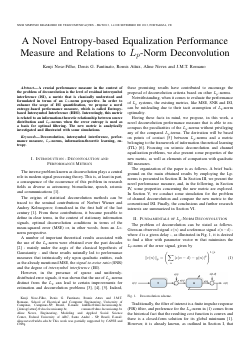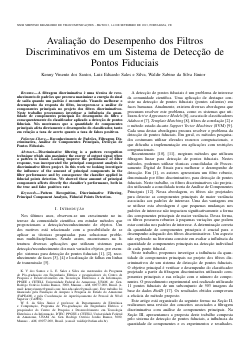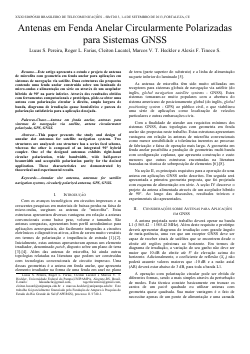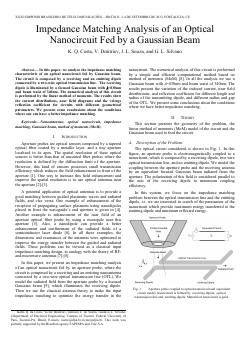
XXXI Simpósio Brasileiro de Telecomunicações

Análise do algoritmo LMS por difusão em redes heterogêneas
Amanda de Paula, Cristiano M. Panazio
DOI: 10.14209/sbrt.2013.25
Keywords: algoritmo adaptativo LMS por difusão análise de autovalores.
Abstract
Nesse artigo é apresentada uma análise do algoritmo LMS por difusão no contexto especı́fico em que cada nó na rede possui uma SNR diferente. Através de uma análise de autovalores, é mostrada qual condição os passos de adaptação de cada nó da rede deve obedecer, a fim de garantir que o algoritmo apresente uma taxa de convergência fixada. Sob essa condição, é mostrado como o passo de adaptação de cada nó na rede deve ser definido de modo que o mı́nimo MSD seja obtido. Os resultados teóricos são também ilustrados com exemplos de simulação.Download

Uma Representação Kotel’nikov para Wavelets e Bancos de Filtros sem Superposição Espectral
H. M. de Oliveira, R. J. Cintra, R. C. de Oliveira
DOI: 10.14209/sbrt.2013.90
Keywords: —wavelets banco de filtros Q-constante wavelets ortogonais representação passa-faixa para wavelets
Abstract
Neste artigo apresenta-se uma representação para wavelets usando sinais em banda básica, explorando resultados de Kotel’nikov. Detalhes de como obter os processos de envoltória e de fase em baixa frequência são apresentados. A interpretação clássica de wavelets como uma análise com banco de filtros de fator de qualidade constante é revisitada nestas bases. Mostra-se que se o suporte espectral da wavelet é limitado na banda [fm,fM], então uma análise ortogonal é garantida provido que fM≤ ≤≤ ≤3fm, um resultado simples, porém que invoca um paralelo com a taxa de Nyquist. Contudo, para espectro de wavelets ortogonais que não verificam esta condição, mostra-se como construir um banco de filtros “equivalente” sem superposição espectral.Download

Sistema de Detecção de Pontos Fiduciais utilizando Classificadores Lineares C-SVC
Luiz Eduardo Sales e Silva, Kenny Vinente dos Santos, Waldir Sabino da Silva Júnior
DOI: 10.14209/sbrt.2013.97
Keywords: SVM pattern detection fiducial points.
Abstract
Currently, there is a growing interest from the scientific and/or industrial community in respect to methods that offer solutions to the problem of fiducial points detection of human faces. Some methods use the SVM for classification, but we observed that some formulations of optimization problems were not discussed. In this article, we propose to investigate the performance of mathematical formulation C-SVC when employed in a classifier for fiducial points detection system of human faces. An important aspect this research is to explore the parameters that have not been used in the literature for training the SVM. In terms of comparison, the results demonstrate that the proposed method has competitive performance and, in some cases, the proposed method outperforms others.Download

A Novel Entropy-based Equalization Performance Measure and Relations to L p -Norm Deconvolution
Kenji Nose-Filho, Denis G. Fantinato, Romis Attux, Aline Neves, J.M.T. Romano
DOI: 10.14209/sbrt.2013.91
Keywords: Deconvolution intersymbol interference perfor- mance measure L p -norms information-theoretic learning en- tropy.
Abstract
A crucial performance measure in the context of the problem of deconvolution is the level of residual intersymbol interference (ISI), a metric that is classically understood and formulated in terms of an L 2 -norm perspective. In order to enhance the scope of ISI quantification, we propose a novel entropy-based performance measure, which is called Entropy- based Intersymbol Interference (HISI). Interestingly, this metric is related to an information-theoretic relationship between source distribution and L p -norms when the error entropy is used as a basis for optimal filtering. The new metric is analytically investigated and illustrated with some simulations.Download

Avaliação do Desempenho dos Filtros Discriminativos em um Sistema de Detecção de Pontos Fiduciais
Kenny Vinente dos Santos, Luiz Eduardo Sales e Silva, Waldir Sabino da Silva Júnior , Waldir Sabino da Silva Júnior
DOI: 10.14209/sbrt.2013.98
Keywords: Pattern Recognition Discriminative Filtering Principal Component Analysis Fiducial Points Detection
Abstract
Discriminative filtering is a pattern recognition technique which aim maximize the energy of output signal when a pattern is found. Looking improve the perfomance of filter response, was incorporated the principal component analysis in discriminative filters project. In this work we looking investigate the influence of the amount of principal components in the filter performance and by consequence the classifier applied in fiducial points detection. We showed those amount of principal components affects directly the classifier’s performance, both in the true and false positives rate.Download

Cancelamento de Distorções Não Lineares em Sistemas OFDMA com Detecção Multiusuário
Silas L. Silva, C. Alexandre R. Fernandes
DOI: 10.14209/sbrt.2013.92
Keywords: OFDMA iterative correction hard detection nonlinear amplifier multiuser detection.
Abstract
Inthispaper,westudyandanalysetheperformance oftheIterativeCorrectionHardDetectiontechniqueforcancellation of nonlinear distortions in OFDMA communication systems. This technique was developed and widely tested for OFDM systems.However,tothebestofourknowledge,theapplicationof this technique in OFDMA systems is unexplored in the literature. The application of this technique in OFDMA systems requires a multiuser detection for estimating and canceling the distortions introduced by the power amplifier.Download

Antenas em Fenda Anelar Circularmente Polarizadas para Sistemas GNSS
Lucas S. Pereira, Roger L. Farias, Cleiton Lucatel, Marcos V. T. Heckler, Alexis F. Tinoco S.
DOI: 10.14209/sbrt.2013.99
Keywords: Antena em fenda anelar antenas para sistemas de navegação via satélite antena circularmente polarizada GPS GNSS.
Abstract
Este artigo apresenta o estudo e projeto de antenas de microfita com geometria em fenda anelar para aplicações em sistemas de navegação via satélite. Duas estruturas são propostas contendo uma fenda anelar construída sobre um laminado de micro-ondas e alimentação em série ou através de um acoplador híbrido de 90° na parte inferior. Através dos resultados obtidos com ferramentas computacionais e protótipos, pôde-se obter uma antena com polarização circular à direita, ampla largura de banda, diagrama de irradiação quase hemisférico e pureza de polarização satisfatória para a aplicação desejada.Download

Reconhecimento Facial usando Wavelets de Gabor via Álgebra Multilinear
Emanual D. R. Sena, André L. F. de Almeida
DOI: 10.14209/sbrt.2013.93
Keywords: Multilinear Algebra Gabor Wavelets tensor decompositions multimodal images face recognition
Abstract
In this work, we propose a facial recognition system that exploits the multilinear nature of images. The feature extraction occurs in two stages. First, Gabor wavelets are used for feature selection. Then, the higher order singular value decomposition (HOSVD) is applied to separate the multimodal factors of the images. Two approaches based on Euclidean and Mahalanobis distances are proposed, respectively, for the classification of the set of feature vectors. The proposed facial recognition approach exhibits higher average success rates than competing methods. By analyzing the results for various training settings, the proposed approach demonstrates stability when there is deficiency in the amount of training images.Download

Impedance Matching Analysis of an Optical Nanocircuit Fed by a Gaussian Beam
K. Q. Costa, V. Dmitriev, J. L. Souza, G. L. Silvano
DOI: 10.14209/sbrt.2013.100
Keywords: Nanoantennas optical nanocircuit impedance matching Gaussian beam method of moments (MoM).
Abstract
In this paper, we analyze the impedance matching characteristic of an optical nanocircuit fed by Gaussian beam. The circuit is composed by a receiving and an emitting dipole connected by a two-wire optical transmission line. The receiving dipole is illuminated by a focused Gaussian beam with λ =830nm and beam waist of 340nm. The numerical analysis of this circuit is performed by the linear method of moments. The results show the current distributions, near field diagrams and the voltage reflection coefficient for circuits with different geometrical parameters. We present some conclusions about the conditions where one can have a better impedance matching.Download

Spatial Information and Disparity-based Weighting Applied to Stereoscopic Video Quality Assessment
José Vinícius de Miranda Cardoso, Ítalo de Pontes Oliveira, Carlos Danilo Miranda Regis, Marcelo Sampaio de Alencar
DOI: 10.14209/sbrt.2013.94
Keywords: Stereoscopic Video Objective Evaluation Techniques Spatial Perceptual Information Disparity
Abstract
This paper presents new results on the objective evaluation of stereoscopic video quality. A balance between the scores provided by classical objective algorithms and the disparity information of the reference video is presented, along with a comparison between the approximations used to compute the local spatial information. The performance of the proposed technique was verified using statistical metrics (correlation coefficients and root mean square error) that compare the scores provided by the objective algorithms and the subjective results provided by the NAMA3DS1–COSPAD1 stereoscopic video quality database. The obtained results suggest a significant improvement on the performance of the objective algorithms for the proposed technique.Download